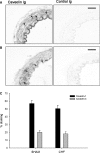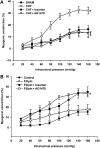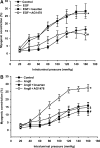Enhanced myogenic constriction of mesenteric artery in heart failure relates to decreased smooth muscle cell caveolae numbers and altered AT1- and epidermal growth factor-receptor function
- PMID: 19147448
- PMCID: PMC2645056
- DOI: 10.1093/eurjhf/hfn027
Enhanced myogenic constriction of mesenteric artery in heart failure relates to decreased smooth muscle cell caveolae numbers and altered AT1- and epidermal growth factor-receptor function
Abstract
Aims: We previously showed that enhanced myogenic constriction (MC) of peripheral resistance arteries involves active AT(1) receptors in chronic heart failure (CHF). Recent data suggest both transactivation of EGF receptors and caveolae-like microdomains to be implicated in the activity of AT(1) receptors. Thus, we assessed their roles in increased MC in mesenteric arteries of CHF rats.
Methods and results: Male Wistar rats underwent myocardial infarction to induce CHF and were sacrificed after 12 weeks. The number of caveolae in smooth muscle cells (SMC) of mesenteric arteries of CHF rats was decreased by 43.6 +/- 4.0%, this was accompanied by increased MC, which was fully normalized to the level of sham by antagonists of the AT(1)-receptor (losartan) or EGF-receptor (AG1478). Acute disruption of caveolae in sham rats affected caveolae numbers and MC to a similar extent as CHF, however MC was only reversed by the antagonist of the EGF-receptor, but not by the AT(1)-receptor antagonist. Further, in sham rats, MC was increased by a sub-threshold concentration of angiotensin II and reversed by both AT(1)- as well as EGF-receptor inhibition. In contrast, increased MC by a sub-threshold concentration of EGF was only reversed by EGF receptor inhibition.
Conclusion: These findings provide the first evidence that decreased SMC caveolae numbers are involved in enhanced MC in small mesenteric arteries, by affecting AT(1)- and EGF-receptor function. This suggests a novel mechanism involved in increased peripheral resistance in CHF.
Figures






Similar articles
-
Myogenic constriction is increased in mesenteric resistance arteries from rats with chronic heart failure: instantaneous counteraction by acute AT1 receptor blockade.Br J Pharmacol. 2003 Aug;139(7):1317-25. doi: 10.1038/sj.bjp.0705367. Br J Pharmacol. 2003. PMID: 12890711 Free PMC article.
-
Congestive heart failure induces downregulation of P2X1-receptors in resistance arteries.Cardiovasc Res. 1999 Jul;43(1):219-27. doi: 10.1016/s0008-6363(99)00060-7. Cardiovasc Res. 1999. PMID: 10536707
-
Enhanced Ca2+-induced contractions and attenuated alpha-adrenoceptor responses in resistance arteries from rats with congestive heart failure.Eur J Heart Fail. 2001 Jan;3(1):7-13. doi: 10.1016/s1388-9842(00)00097-0. Eur J Heart Fail. 2001. PMID: 11163729
-
Cysteinyl leukotriene 1 receptors as novel mechanosensors mediating myogenic tone together with angiotensin II type 1 receptors-brief report.Arterioscler Thromb Vasc Biol. 2015 Jan;35(1):121-6. doi: 10.1161/ATVBAHA.114.304844. Epub 2014 Nov 13. Arterioscler Thromb Vasc Biol. 2015. PMID: 25395620
-
Acetylcholine stimulated dilatation and stretch induced myogenic constriction in mesenteric artery of rats with chronic heart failure.Eur J Heart Fail. 2007 Feb;9(2):144-51. doi: 10.1016/j.ejheart.2006.05.003. Epub 2006 Jul 7. Eur J Heart Fail. 2007. PMID: 16828577 Review.
Cited by
-
A Bioinformatics Investigation into the Pharmacological Mechanisms of Sodium-Glucose Co-transporter 2 Inhibitors in Diabetes Mellitus and Heart Failure Based on Network Pharmacology.Cardiovasc Drugs Ther. 2022 Aug;36(4):713-726. doi: 10.1007/s10557-021-07186-y. Epub 2021 May 24. Cardiovasc Drugs Ther. 2022. PMID: 34028657 Free PMC article.
-
Reduced vascular smooth muscle BK channel current underlies heart failure-induced vasoconstriction in mice.FASEB J. 2013 May;27(5):1859-67. doi: 10.1096/fj.12-223511. Epub 2013 Jan 16. FASEB J. 2013. PMID: 23325318 Free PMC article.
-
Cardiac remodeling and physical training post myocardial infarction.World J Cardiol. 2015 Feb 26;7(2):52-64. doi: 10.4330/wjc.v7.i2.52. World J Cardiol. 2015. PMID: 25717353 Free PMC article. Review.
-
Evidence That ADAM17 Mediates the Protective Action of CGRP against Angiotensin II-Induced Inflammation in Vascular Smooth Muscle Cells.Mediators Inflamm. 2018 Jun 12;2018:2109352. doi: 10.1155/2018/2109352. eCollection 2018. Mediators Inflamm. 2018. PMID: 30046277 Free PMC article.
-
Arteriolar vascular smooth muscle cells: mechanotransducers in a complex environment.Int J Biochem Cell Biol. 2012 Sep;44(9):1505-10. doi: 10.1016/j.biocel.2012.05.021. Epub 2012 Jun 5. Int J Biochem Cell Biol. 2012. PMID: 22677491 Free PMC article. Review.
References
-
- Schrier RW, Abraham WT. Mechanisms of disease - Hormones and hemodynamics in heart failure. N Eng J Med. 1999;341:577–585. - PubMed
-
- Davis MJ, Hill MA. Signaling mechanisms underlying the vascular myogenic response. Physiol Rev. 1999;79:387–423. - PubMed
-
- Kagiyama S, Eguchi S, Frank GD, Inagami T, Zhang YC, Phillips MI. Angiotensin II-induced cardiac hypertrophy and hypertension are attenuated by epidermal growth factor receptor antisense. Circulation. 2002;106:909–912. - PubMed
-
- Ushio-Fukai M, Hilenski L, Santanam N, Becker PL, Ma Y, Griendling KK, Alexander RW. Cholesterol depletion inhibits epidermal growth factor receptor transactivation by angiotensin II in vascular smooth muscle cells: role of cholesterol-rich microdomains and focal adhesions in angiotensin II signaling. J Biol Chem. 2001;276:48269–48275. - PubMed
Publication types
MeSH terms
Substances
LinkOut - more resources
Full Text Sources
Medical
Research Materials

